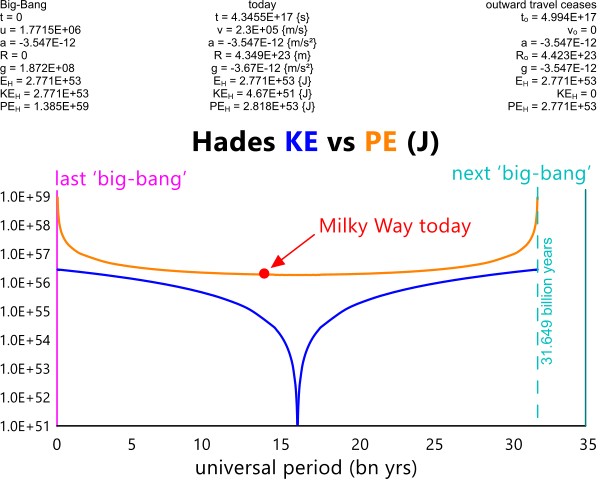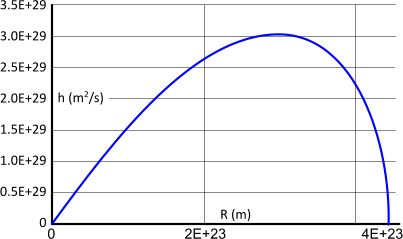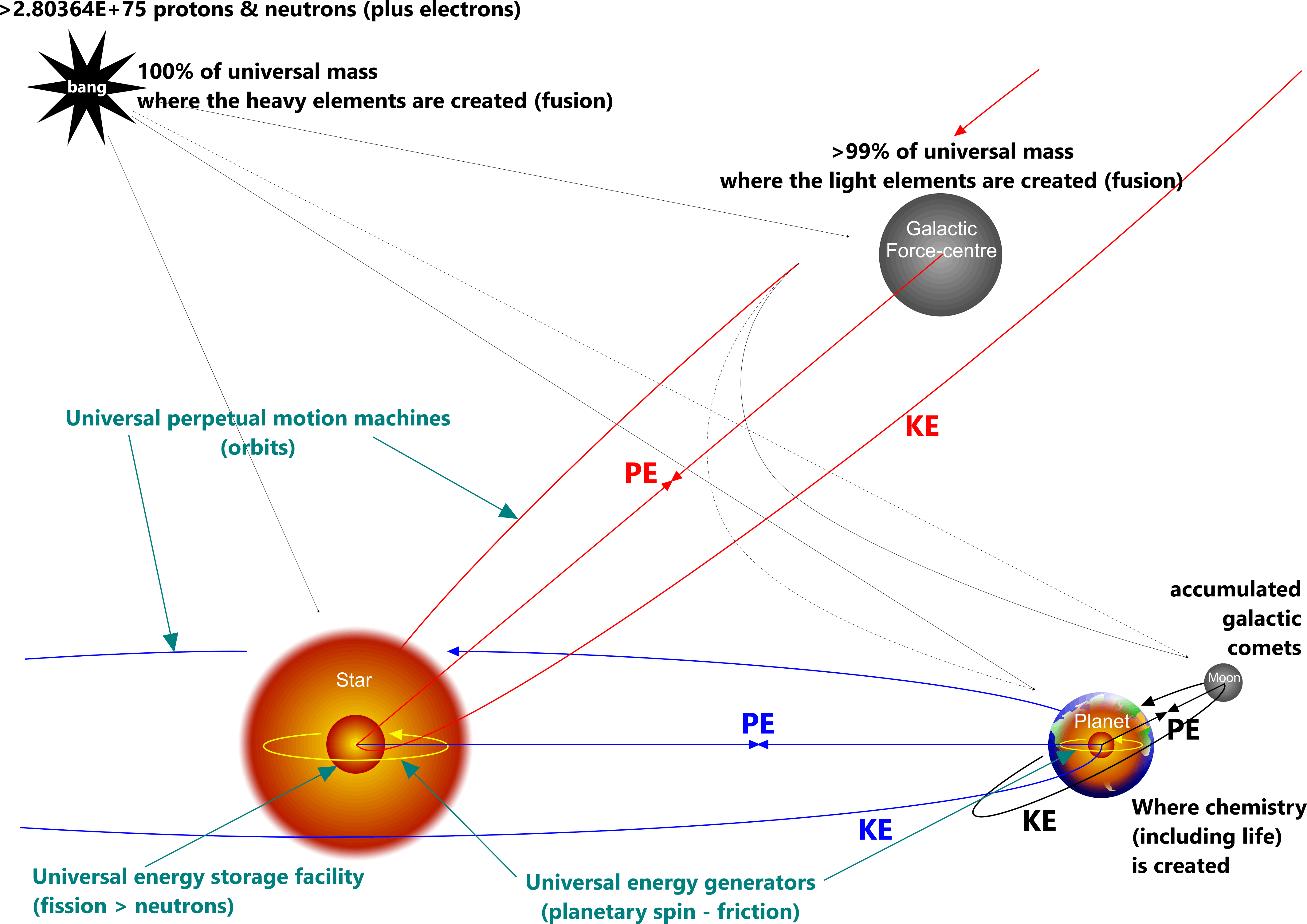The Universe (how it really works!)
{© 01/04/19}This web page is an explanation by Keith Dixon-Roche of the origins and workings of the universe.
Problems with today's theories
The reason we know no more about the workings of the universe than we did a hundred years ago, is because we still believe in photons, dark-matter, black-holes, event horizons, relativity and quantum theory.
If we bypass these theories, go back to the pre-twentieth century physicists and start again, the universe can be easily explained with simple maths, obeying the conservation of energy and the laws of thermodynamics. And you do this by taking Isaac Newton's laws of Motion to their logical conclusion.
The Ultimate Body (the mass of the universe)
If a mass is large enough, its core pressure will exceed the coupling ratio in its innermost atoms forcing two neutrons to make contact, initiating their unnatural decay and releasing their stored energy.
The resultant chain reaction is exactly the same as that released in an atom bomb, only much more powerful due to the body's size and the number of neutrons involved.
The minimum mass (mᵁ) required to achieve this condition is >4.7E+48kg, this is therefore the minimum mass of the universe, and relates to >2.8E+75 proton-electron pairs and neutrons.
This explosive chain reaction has become known as the 'Big-Bang', which probably released more than 7.3544E+60 Joules of neutron energy.
Because it is cold, the ultimate body will have had sufficient internal pressure throughout most of its mass to fuse most of its elements. Moreover, such fusion energy at the core of the ultimate body will be sufficient to fuse smaller elements to the heavy elements, albeit these heavy elements will have a much smaller neutron ratio than the radioactive matter we are used to.
Because fusion was possible inside the ultimate body, we can postulate that its maximum [average] density was similar to that of the heaviest stable elements; e.g. lead; ρ < 11,000 kg/m³, which would result in a gravitational acceleration at its surface ≈ 1.464E+08 times greater than at the surface of our own planet.
Universal Period
Immediately after any 'Big-Bang', most of the ultimate body's matter is blasted into outer space at an initial velocity of approximately 1.77E+06 m/s (see Size and Age of the Universe below); commensurate with the energy released. But, as with any explosion, residual matter will have been left behind, that accreted into a single, central body, which we will call the Great Attractor.
The matter ejected will have comprised various sizes of discrete bodies, the largest of which became the galactic force-centres, and the smaller of which will have entered into orbit - owing to gravitational pull and variable relative velocity - around the galactic force-centres.
As the galaxies travel away from the 'Big-Bang', the potential energy induced by the Great Attractor is slowing down their travel-rate; it is claimed that the Milky Way's velocity today is 2.3E+05 m/s⁽²⁾. Eventually, this potential energy (gravity) will stop it altogether and return it all to a common point, where it will re-accumulate into another ultimate body. After which, the coupling ratio will again be compromised and another 'Big-Bang' will occur. This repeating event occurs naturally; it requires no outside assistance.
This is also the reason why almost all universal matter, including meteorites, possess the proteins that form the origins of life. Life did not begin here on Earth; it began on a planet countless 'Big-Bangs' ago and has been distributed throughout the universe by now.
The time between these 'Big-Bangs' is a universal period.
Size and Age of the Universe
Input Data:
Our universe is today, apparently about 13.77 billion years old;
t ≈ 4.34548152E+17 {s} ⁽¹⁾.
and our galaxy is today apparently travelling away from the 'Big-Bang' at;
v ≈ 2.3E+05 {m/s} ⁽²⁾
Because the 'Big-Bang' is the same process as an atom bomb, we can assume a similar neutron loss as that experienced by 'Little-Boy';
% = 3%
The most common element in the universe is apparently iron, which has a neutron ratio of;
ψ = 1.147962
The mass of our own galactic force-centre, which I refer to as 'Hades for reasons of convenience;
mH = 1.76572E+41 kg
Calculations:
We can calculate the mass that will generate the atomic force required to cause two neutrons to make contact - assuming a perfect sphere - which gives us a minimum mass of;
mᵁ = (k.e² / G.φ.mₙ)+1 = 4.68688E+48 {kg}
All viscous matter will flow, irrespective of its temperature, if subjected to sufficient gravitational acceleration.
Let's assume (conservatively) that the average density of the ultimate body is 11,000 kg/m³, its surface radius will be;
r = ³√[3.mᵁ / 4π.ρ] = 4.66804E+14 {m}
resulting in a gravitational acceleration at its surface of;
g = G.mᵁ/r² = 1.4354E+09 {m/s²}
or 1.464E+08 times that at the surface of the earth.
Whilst this is a lot, it may not be sufficient to force rock to flow at 2.7255 K, so the sphere may not be perfect, and its mass therefore greater. So, whilst the following calculations will be based upon the minimum ultimate body mass, we can be quite confident that it will most probably be;
4.68688E+48 < mᵁ ≤ 1E+49 {kg}.
Assuming 3% of the ultimate body's neutrons were split during the 'Big-Bang', the energy released will be at least;
number of proton-electron pairs; Nₚₑₚ > mᵁ/mₙ > 2.80059E+75
number of neutrons; Nₙ > Nₚₑₚ . (1-1/(1+ψ)) > 1.49675E+75
total neutronic energy in the ultimate body; Eₜ > Eₙ.Nₙ > 2.45147E+62 {J}
neutron energy released during the 'Big-Bang'; E > Eₜ . % > 7.35440E+60 {J}
Next, we need to determine the initial velocity of all the ejected matter, which can be calculated from its kinetic energy. At the instant of the 'Big-Bang' all of the energy released (E) will have been converted to kinetic energy in all the ejected matter, giving the ejected matter an initial velocity of;
u = √[2.E/(mᵁ-mᴳᴬ)] = 1.7734984104391E+06 {m/s}
Using our own galactic force-centre (Hades), its proportion of this kinetic energy will be;
EH = E . mH/mᵁ = 2.77067520630515E+53 {J}

Fig. 1 A Universal Period
Hades' acceleration through space is a constant, and may be calculated from its performance today;
a = (v-u)/t =-3.55196174079941E-12 m/s²
The time elapsed when Hades comes to a halt may be calculated from 'v-u = a.t' when v = 0;
tₒ = -u/a = 4.99301101717368E+17 s (15.8218971568614 bn-yr)
The distance Hades has travelled from the 'Big-Bang' today can be calculated thus;
R = u.t + ½.a.t² = 4.35308265895621E+23 m
The gravitational acceleration at the time outward travel ceases is the same as the constant acceleration of Hades;
gₒ = a = -3.55196174079941E-12 m/s²
The distance Hades will have travelled at the tome outward travel ceases (v=0) will be;
Rₒ = ½.(0²-u²)/a = 4.42754855113119E+23 m
The mass of the great attractor can now be established;
mᴳᴬ = -gₒ.Rₒ²/G = 1.04336261407223E+46 kg
The gravitational acceleration induced by the great attractor on Hades today is therefore;
g = G.mᴳᴬ/R² = -3.67452423363053E-12 m/s²
From the above we can now establish the length of a universal period;
2.tₒ = 31.6437943137227 bn-yr
The size of the universe today;
≈2.R ≈ 8.70616531791242E+23 m
The ultimate size of the universe before it begins to re-accrete (contract);
≈2.Rₒ ≈ 8.85509710226237E+23 m
And we are currently 43.51% through our current universal period
Hades' progress through time can now be plotted for the entire universal period (Fig 1)
This means that EME (light), which travels at a constant velocity (c) will - today - take;
t = 2.R/c = 2.90406414723E+15 seconds to traverse the universe. And because the universe is much older (4.34548E+17 s), a telescope with sufficient definition should enable us to see the entire universe.
And because EME travels at a constant speed (c), that released during the last 'Big-Bang' will have travelled;
d = c.t = 1.30274259042E+26 {m}
or almost 300 times the outermost radius of the universal ellipsoid today. Therefore, any EME detected in outer-space today, cannot possibly be left over from the last 'Big-Bang', it can only be that radiated by all the active planets and stars in the universe.
Given that the mass of the rubble left over after the 'Big-Bang' is 0.222613525% that of the ultimate body, the initial velocity - on which all the subsequent energy calculations are based - must be more than 99.77739% accurate.
Isaac Newton's Constants

Fig. 2 Newton's Constant of Motion for Linear Orbits
Newton's constant of proportionality works perfectly - with equal accuracy - to the linear expansion of galaxies following the last 'Big-Bang' as follows:
K = (2π)² / G.m₁ = (2π)² / 2.Rₒ.(u/2)² = 2.π² . tₒ² / Rₒ³ (m₁ = mᴳᴬ):
which give us the following value for the great attractor;
K = 5.66976153229753E-35 {s²/m³}
Note: the above value for 'K' is based upon NASA's claims for today's velocity of the Milky Way⁽²⁾ and their estimated "age of the universe"⁽¹⁾.
Newton's constant of motion, however does not work with universal expansion (Fig 2);
h = R.v = variable
but this is the only elliptical orbit constant that does not transfer to linear orbits.
Discussion
NASA claims to have established the age of the universe today based upon 'background radiation' and Relativity⁽¹⁾. But the only radiation in the universe is the EME radiated by all of its celestial bodies, and given that EME travels at 'c', that emitted during the last 'Big-Bang' is far outside (1.3027E+26 m) the furthest reaches of our universe today (4.3531E+23 m). It certainly doesn't exist around Jupiter! And Relativity is a myth based on fantasy. So, NASA cannot possibly claim to know the age of the universe today.
The current velocity of Hades would help with a solution, but without a coincident distance from the great attractor, it is insufficient information.
The above formula (G . √[m₂ / 2.E.u²] = Rₒ / m₁) shows us that establishing either the mass of the great attractor (m₁), or the distance Hades will reach when outward travel ceases (Rₒ), would give us everything we need to know about the performance of the universe throughout a universal period. Then, by establishing a true velocity of Hades today, we can easily determine its distance from the great attractor and the age of the universe.
Whilst a solution to the age of the universe depends on establishing either m₁ or Rₒ, because Rₒ is dependent upon m₁, you need to resolve the mass of the great attractor (the rubble left over after the 'Big-Bang') in order to determine how far ejected matter will travel before outward movement ceases. In the above calculation, the mass selected is that which will achieve a universal age and velocity today as defined by NASA, which cannot possibly be correct⁽¹⁾.
By now, after many billions of years, all the ejected matter that did not travel as far as the extant galaxies will have long ago ceased outward travel and returned (or is still returning) to the great attractor, augmenting its mass. This is how we know that the universe today, is a collection of galaxies at the periphery of an ellipsoid.
It would appear that the great attractor may be approximately 0.25% of the mass of the ultimate body; i.e. that of all universal matter. But a representative value can only be found if we can establish the percentage of matter left behind after an atomic explosion.
The Great Attractor
The Great Attractor is simply the re-accreted rubble left behind after a 'Big-Bang'. As defined in 'The Size and Age of the Universe above,' it is about 1.043363E+46kg (≈0.2226% of all universal mass).
Whilst it is a force-centre, its satellites are in linear orbits, and is therefore cold (dark). Its function is to return all universal mass to a common point - via potential energy (Gravity) - and thereby initiate the next 'Big-Bang'.
Its mass means that the Great Attractor's density is probably similar to that expected of the ultimate body (11,000 kg/m³), so fusion will occur in its core.
This will give it a radius of; r ≈ ³√[3.m / 4.π.ρ] ≈ 6.09515366130185E+13 m
and a gravitational acceleration at its surface of; g ≈ G.m / r² ≈ 187,424,182.83575 m/s² #
# 1.9111E+07 times greater than at the surface of our own planet
Galactic Force-centres
Galactic force centres are the largest chunks of matter that were ejected during the last 'Big-Bang'. They were - and still are - travelling in a straight line away from what's left of the ultimate body (the great attractor). Because they are linear satellites, they are cold (dark). However, their own satellites will induce spin in them.
Because they are cold (dark) they are essentially invisible in outer space. They emit negligible electro-magnetic energy, and the EME that they do emit is of exceptionally long wavelength. We cannot today detect it. These bodies were therefore declared non-existent by the scientific community and replaced with dark-matter.
However, it is now believed that there is a black-hole at the centre of every galaxy. Yet despite its motive having been removed, most scientists still believe in the existence of dark matter.
The reason a galactic force-centre is cold, is because it is in a linear orbit. So, there is very little relative spin between its core and its mantle matter, and therefore generates negligible internal frictional heat.
Newton's laws of orbital motion enable us to calculate their mass, and spin theory gives us the ability to calculate their angular velocity.
Having been able to estimate the mass and spin-rate of our own galactic force-centre, it is now possible to estimate the number of galaxies in the universe; >2.66E+07
Galactic force-centres have sufficient mass to generate the internal pressures necessary to fuse smaller elements, because they are cold.
Although fusion is possible inside our own galactic force-centre, it is not to the same extent as in the ultimate body, but because it is cold, we can postulate that its average density may well be a little more than that of iron; ρ ≈ 9,000 kg/m³
giving it a radius of ≈ 1.673E+12 m
and a gravitational acceleration at its surface of; ≈ 4.21E+06 m/s² #
# 430,000 times greater than at the surface of our own planet
Outer Space
Outer space is not full of dark matter; it is empty.
The only thing in outer space is the electro-magnetic energy (EME) radiated by all the celestial bodies in it. This EME is responsible for generating the little heat that exists out there. Its temperature is; 2.7255K.
Because the temperature of outer space is so low, we know that the only natural gas that can exist in it is hydrogen (H). Therefore, we also know that our solar system cannot have accreted from gas.
How it Works
The image below describes the workings of our universe during any universal period.

The above model explains every celestial body; where it came from, how old it is (the same age as the universe itself), why it looks and behaves the way it does, etc.
It can repeat itself eternally with no outside help and yet conform to all three laws of thermodynamics and the conservation of energy.
Notes
- NASA currently claims that the universe is about 13.77 billion years old, but they define this value by;
"... making detailed observations of the fluctuations in the cosmic microwave background and using that information in Einstein's Theory of General Relativity to 'run the clock backwards to time equal zero'".
This age is therefore guesswork based upon a myth, which means that the age of the universe is today unknown. - NASA currently claims that our galaxy is travelling through space at approximately 2.3E+05 m/s. However, whilst this estimate should be more reliable than their estimate of the "age of the universe" as it is simply based upon the red-shift of adjacent galaxies, it is clearly not a calculated value, and must therefore be a guess.
We should therefore also treat this value with caution.
Further Reading
You will find further reading on this subject in reference publications(74)